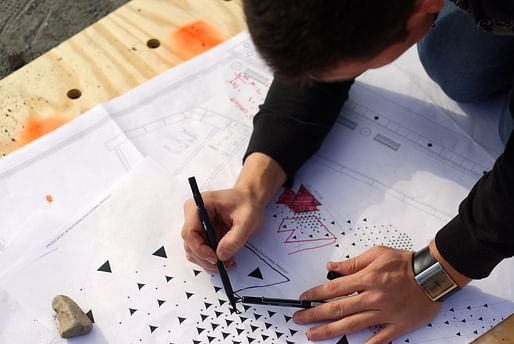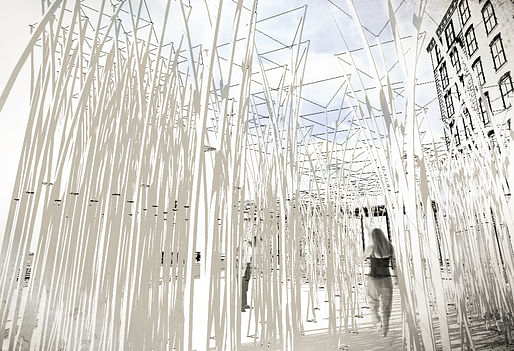

Exhibited as an installation on the Atlantic Wharf in Boston, MA, this project utilizes a field of PVC pipes to evoke a sense of immersion in varying densities.
A group of 12 students, 1 instructor and 1 wood-shop technician traveled throughout New York City, Big Bend National Park in Texas and Marfa Texas, the location of the Chinati Foundation founded by artist Donald Judd. We have set out to design and build an Architectural Installation inspired by our experiences of our ten-day travel.
Samantha Altieri
Viviana Bernal
Erblin Bucaliu
Kate Bujalski
Alex Cabral (wood shop technician)
Brittany Carey
Kristen Giannone
Ryan Kahen
Mark Morin
Bao Nguyen
Samantha Partington
Charlie Simmons
Liem Than
Robert Trumbour (instructor)
Location: Atlantic Wharf, Boston MA
Exhibit: Site Installation
On Site: Monday December 3 – Monday March 11
Studio Description:
The artist Ann Hamilton describes installation as the making of art in relation. Implied in this definition is the notion of place, the art is in relation to the place in which it resides. This studio will consider the relations between art, architecture, landscape and the body. Binding these considerations will be the dimension of time. The studio will be structured as an intensive design and fabrication research collaborative that aims to address the nature of site specificity, landscape, environments, scale, emerging digital design & fabrication methods and full-scale building. The group will be responsible for the design, prototyping, fabrication, and the assembly of a large-scale installation at the conclusion of the studio. Inspired by Robert Smithson’s notions of Site, Non- Site, the methodology for the studio will involve a series of mapping and recording exercises beginning in Big Bend. Data collected will be brought back to Boston and reinterpreted, leading to the questioning of site, scale, materiality and place all in relation to one another. Topics to be discussed and explored include contemporary installation art, site-specific art and architecture, physical & interactive computing, digital fabrication, mapping, recording and landscape.
Our medium will be installation. Installation art since it’s beginnings in the 1960’s has proven to be a provocative mode of experimentation for many artists. In many instances, the historical boundaries of the private studio and gallery have been broken down leading the way for work that is in dialog with it’s surroundings. The work of Robert Smithson during the late 60’s and early 70’s pioneered the Land Art movement and encouraged other artists of his generation to leave the confines of their studios. Donald Judd was, by the 1960’s already an established artist. His work began as figural and expressionistic but eventually became increasingly abstract by the early 1960’s. During this period, Judd redirected his method of making to include industrial processes and fabrication methods, ultimately leaving the making of his work to local craftsman. After a retreat to Marfa, Texas in the early 1970’s Judd became captivated by its desert landscape eventually buying land in Marfa and establishing a studio. His acquisitions of land increased and ultimately lead to the establishment of the Chinati Foundation in 1986, a non-profit arts foundation dedicated to the work of Judd and his contemporaries. During this time Judd expanded on his notion of site-specificity, which lead to a series of obsessively detailed architectural renovations and new constructions to house his interior sculpture. Donald Judd, his work and his method are of particular interest to this fall’s studio. His participation in installation art, his appreciation for landscape and his obsession with craft and fabrication offer a body of work ripe for study.
We are currently looking for donations that will be put towards material and fabrication costs.
Please visit http://www.gofundme.com/WITgradstudio
For photos of the trip, please visit our facebook page
https://www.facebook.com/WITgradstudio






This blog will be used to post various entries about the Wentworth lecture series, the Wentworth Architecture Review magazine, and other entries related to architecture.
No Comments
Block this user
Are you sure you want to block this user and hide all related comments throughout the site?
Archinect
This is your first comment on Archinect. Your comment will be visible once approved.